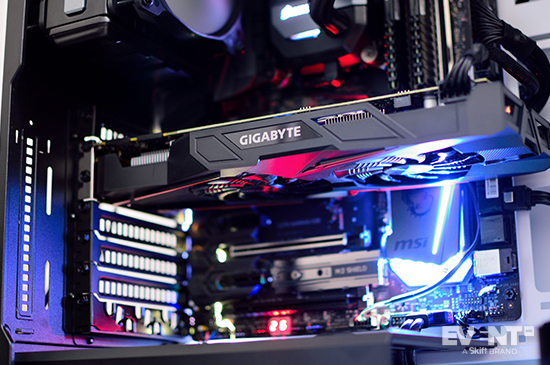This year, the Consumer Electronics Show (CES) was fully virtual for the first time ever. The event took place from January 11th – 14th and included its usual round-up of exciting innovations and announcements from around 2,000 exhibiting companies.
As the event concluded, CES 2021 announced that it broke records as the largest virtual tech industry event to date, although no attendance numbers were released. Expectations for this year’s CES were high, as the organizers strived to recreate the typical show experience and invested heavily in their virtual platform, which was custom-designed and built in partnership with Microsoft.
EventMB took a look at how CES managed its virtual pivot, including attendee sentiments, and noted some interesting tech innovations that could impact events in the near future.
CES Goes Virtual
The Consumer Technology Association — the organization that owns and produces CES — decided back in July of last year that the next edition would be virtual. This gave the event ample time to plan its transition and build its platform.
It was billed as a “highly personalized experience,” which translated into features such as personal agendas and personalized content and connection recommendations.
CES 2021 implemented several of the virtual event best practices that we have been sharing for the past few months. For example, a tutorial of its digital venue was provided ahead of the event to familiarize attendees with the platform and its features. Closed captioning and AI-powered translations were also included.
In addition, all event content is now available on demand through the event platform until February 15th. Registered attendees can also continue to engage with exhibitors and connect with each other until then.
In terms of pricing, the cost of attendance was $149 for registrations before January 4th, which was half the cost of 2020’s lowest ticket tier, but still substantial for a virtual event. After January 4th, the ticket price increased to $499.
WAS CES’S TRANSITION TO VIRTUAL A SUCCESS?
Trade shows don’t have the best track record when it comes to transition to a virtual format, and reactions to CES 2021 were somewhat mixed. It was still able to deliver interesting keynotes and exciting tech announcements, but some attendees felt that the trade show experience was lacking. And while CES took data privacy seriously, the related notifications were another cause for complaint among attendees.
Another issue that has been raised was the event’s use of pre-recorded sessions. While pre-recorded sessions can be helpful in some instances, the problem for CES was that they prevented certain speakers from addressing current events — specifically, the banning of President Trump from social media platforms.
However, that’s not to say that there were no positive reactions. Some participants enjoyed the digital format and still found ways to socialize.
Event-Related Tech Announcements
The innovations and trends discussed at CES span several sectors, from retail to automotive to gaming. Here’s an overview of some of the most interesting tech and other developments that may affect the future of events.
VIRUS DETECTING AND PURIFYING TECH
Much of the new tech unveiled at CES revolved around Covid safety. Airthings, which produces indoor air quality monitors, unveiled a new product, the Wave Plus for Business Virus Risk Indicator. This monitor calculates the risk of virus transmission indoors by analyzing factors such as ventilation rate and virus survival rate.
Several companies, including CleanAirZone, also showcased new air purifiers that filter out SARS-CoV-2 particles (the virus that causes Covid-19) from the air. Moving forward, these technologies may help eventprofs and venues implement further safety measures for in-person events.
ENHANCED SAFETY AT VENUES
CES included two sessions, “Tech-Driven Solutions for Fan Safety and Engagement” and “Getting Back Together Safely” that centered around the safe return to live venues, specifically for sporting events and concerts.
The panelists discussed the safety-enhancing tech that many venues are now using, such as UVC disinfection lights. There has also been an increased reliance on logistical advances like electronic ordering to limit lines and speed up the flow of traffic. The overall outlook was optimistic, and speakers noted that hybrid offerings will help boost venues’ return post-Covid.
NEW VIRTUAL EVENT EXPERIENCES
MediaLink and iHeartRadio, which normally host in-person parties at CES, partnered to organize a virtual gathering at this year’s show using the Spatial Web platform. Attendees were able to roam the virtual environment with avatars and network with each other before viewing an interview with Ryan Seacrest and Dua Lipa.
Although the concept of an immersive virtual environment is not quite new, Spatial Web aims to further humanize online events through features like spatial audio, which increases the volume of nearby conversations as you approach them, and rooms that attendees can spontaneously hold private meetings in.
IMPROVEMENTS TO WORK-FROM-HOME SETUPS
With the pandemic forcing millions of people to work from home, a lot of CES tech focused on improving the remote work experience. One such product was a new digital condenser microphone launched by electronics company Shure, which is aimed at improving audio quality for video conferencing. At $99, it’s a relatively affordable option that virtual event organizers may consider looking into for speakers and moderators joining remotely.
IN CONCLUSION
CES 2021 was not quite as groundbreaking as many expected from a tech-focused show, and it struggled to recreate the full value of its usual in-person experience — which is not a problem unique to CES.
However, while nothing will ever replace the ability to physically roam the show floor and visit booths at a trade show, the event still managed to deliver engaging content to a virtual audience. This included new product announcements from exhibitors, some of which may help the return to live events or enhance virtual and hybrid experiences.





